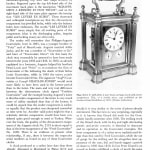
Charles Allix, "Carriage Clocks, their History and Development", 1974, p. 311, pls. X/5 and 6, illustrating an almost identical clock and its complicated movement by 'Fritz' Courvoisier, also signed C.F. Klentschi on the movement, in the Musée d'Horlogerie à La Chaux-de-Fonds.

Derek Roberts, "Carriage and other Travelling Clocks", 1993, pp. 242-3, pl. 154 a & b, illustrating another very similar carriage clock by Courvoisier.
Peter Girard
Further images
Literature
Alfred Chapuis, "Histoire de la Pendulerie Neuchâteloise", 1917, pp. 432-3, illustrating and describing an almost identical clock and its movement by 'Fritz' Courvoisier.
Charles Allix, "Carriage Clocks, their History and Development", 1974, p. 311, pls. X/5 and 6, illustrating an almost identical clock and its complicated movement by 'Fritz' Courvoisier, also signed C.F. Klentschi on the movement, in the Musée d'Horlogerie à La Chaux-de-Fonds.
Derek Roberts, "Carriage and other Travelling Clocks", 1993, pp. 242-3, pl. 154 a & b, illustrating another very similar carriage clock by Courvoisier.
A very rare and superb quality fully engraved gilt brass Swiss Grande Sonnerie carriage clock, signed on the backplate Pre. Girard Chaux-de-Fonds. The white enamel dial with Roman numerals and gilt brass hands for the hours and minutes with subsidiary seconds disc below 12 o'clock and two further subsidiary discs below the main dial, one to left for the alarm and the other to the right for calendar indications. The movement with pivoted detent chronometer escapement, compensated balance, grande sonnerie from 8 p.m. until 8 a.m. automatically changing to petit sonnerie during the day, striking, alarm and repeat with calendar indications. The gilt brass case with a fine engraved mask, glazed front, top and sides, housed in its original tooled leather travelling case with backward opening top to reveal the finely cast carrying handle, glazed top and repeat lever
La Chaux-de-Fonds, Switzerland, date circa 1850
Height with handle 18 cm.
This clock is very similar to the series of pieces by Courvoisier. This fact is not surprising, especially as it is known that Girard did work for the Courvoisier family, sometime after 1820. In fact Peter Girard is on record as having exhibited a clock of much the same specification at the London Great Exhibition of 1851.



